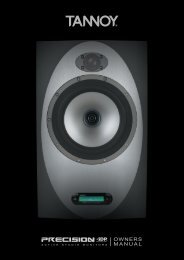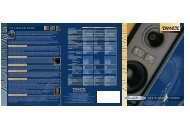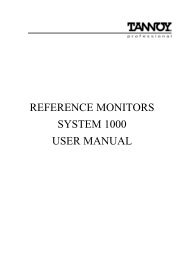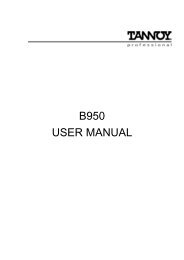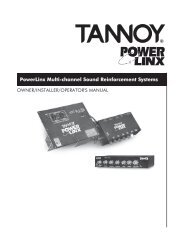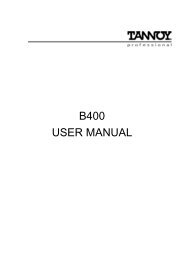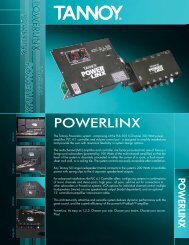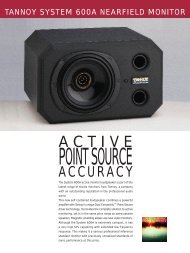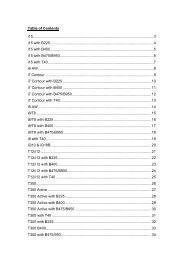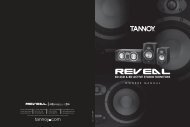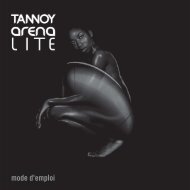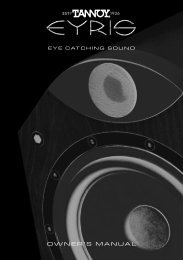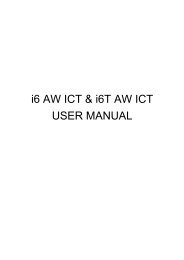iQ SERIES USER MANUAL - Tannoy
iQ SERIES USER MANUAL - Tannoy
iQ SERIES USER MANUAL - Tannoy
You also want an ePaper? Increase the reach of your titles
YUMPU automatically turns print PDFs into web optimized ePapers that Google loves.
<strong>iQ</strong> <strong>SERIES</strong><br />
<strong>USER</strong> <strong>MANUAL</strong><br />
<strong>iQ</strong> 10, <strong>iQ</strong> 10P, <strong>iQ</strong> 10C AND<br />
<strong>iQ</strong> 10PC MODELS
CONTENTS<br />
1. Introduction<br />
2. Unpacking<br />
3. Connectors/Cabling<br />
4. Amplification & Power Handling<br />
5. Operation<br />
6. Equalisation<br />
7. Arraying<br />
8. Dimensions<br />
9. Rigging & Suspension<br />
General Safety Advice<br />
Skeletal Flying<br />
SECUR – ET VPC Pole Clamp<br />
SECUR ET – VEB Eyebolt<br />
Suspension Truss<br />
10. Performance Data<br />
11. Technical Specifications<br />
12. System Configuration & OEM Controllers<br />
Bi-amp System Parameters (<strong>iQ</strong> 10 & <strong>iQ</strong> 10C)<br />
Passive System Parameters (<strong>iQ</strong> 10P & <strong>iQ</strong> 10PC)<br />
13. Recommended Service Parts & Accessories<br />
14. Warranty<br />
15. Declaration of Conformity
1. Introduction<br />
Thank You for purchasing <strong>Tannoy</strong> PowerDual <strong>iQ</strong> 10.<br />
The <strong>iQ</strong> 10 has been designed for live and fixed installation music and speech sound<br />
reinforcement applications. They are specifically designed for use in venues,<br />
theatres, arenas and distributed systems in stadiums. The <strong>iQ</strong> 10 can be used both<br />
indoors and out due to its durable “skeletonised” plastic weatherproof enclosure.<br />
The <strong>iQ</strong> 10 utilises a point source 10” PowerDual driver utilising the unique Funktion<br />
One Research engineered and patented Axhead technology, which provides a<br />
controlled 60° × 40° (H × V) dispersion, covering a frequency range from 180Hz to<br />
18kHz. For low frequencies, the <strong>iQ</strong> 10 has been designed to operate in conjunction<br />
with the <strong>iQ</strong> 18B sub-woofer, where overall system balance is achieved by using the<br />
TDX1 or TDX2 system controller, with provision for the relevant cross-over<br />
frequencies, delays, gains, high and low pass filters and parametric EQ amongst<br />
other features.<br />
<strong>Tannoy</strong>’s, <strong>iQ</strong> 10 is a weatherproof skeletal design suitable for use both indoors and<br />
out, where the compact and lightweight unit allows for flying into tight corners. The <strong>iQ</strong><br />
10 has two Speakon connectors for ease of installation. An optional plywood<br />
cabinet is also available to match the <strong>iQ</strong> 18B profile where they can be flown together<br />
using additional hardware for flying.<br />
The <strong>iQ</strong>10 comes in 4 variants:-<br />
<strong>iQ</strong> 10 - Skeletal <strong>iQ</strong> 10 Configured for Bi amp operation.<br />
<strong>iQ</strong> 10P -<br />
<strong>iQ</strong> 10C -<br />
<strong>iQ</strong> 10PC -<br />
2. Unpacking<br />
Skeletal <strong>iQ</strong> 10 with internal passive crossover.<br />
<strong>iQ</strong> 10 Configured for Bi amp operation in plywood cabinet.<br />
<strong>iQ</strong> 10 with internal passive crossover in plywood cabinet.<br />
Every <strong>Tannoy</strong> <strong>iQ</strong>10 is carefully tested and inspected before packing. After unpacking,<br />
please inspect your <strong>iQ</strong>10 for any damage sustained during transit. In the unlikely<br />
event of any damage, would you please notify your dealer immediately and retain<br />
your shipping carton, as your dealer may ask the faulty unit to be returned for<br />
inspection.<br />
3. Connectors/Cabling<br />
The <strong>iQ</strong> 10 is fitted with two 4-pole Speakon connectors. Speakon has the<br />
following advantages over EP and XLR type connectors: All terminations are<br />
solderless, making life easier at the time of installation or when field servicing is<br />
required. Contacts will accept 6 sq. mm wire with an outside diameter of up to 15 mm<br />
and a current rating of 30 Amps.<br />
The pins of the Speakon sockets, marked input/output on the rear of the speaker,<br />
are paralleled within the enclosure.<br />
<strong>Tannoy</strong> has adopted the following wiring standard for <strong>iQ</strong> 10: -<br />
Mode Of Operation<br />
Speakon Pin No. Passive (<strong>iQ</strong> 10P, <strong>iQ</strong> 10PC) Bi – Amp (<strong>iQ</strong> 10, <strong>iQ</strong> 10C)<br />
1+ Full Range + LF +<br />
1- Full Range - LF -<br />
2+ No Connectors HF +<br />
2- No Connectors HF -<br />
For a worldwide list of Neutrik distributors see http://www.neutrik.com/<br />
4
Cable choice consists mainly of selecting the correct cross sectional area in relation<br />
to the cable length and the load impedance. A small cross sectional area would<br />
increase the cables series resistance, inducing power loss and response variations<br />
(damping factor).<br />
Connectors should be wired with a minimum of 2.5 sq. mm (12 gauge) cable. This will<br />
be perfectly satisfactory under normal conditions. In the case of very long cable runs<br />
the wire size should exceed this, refer to the following table for guidance: -<br />
CABLE RUN<br />
(m)<br />
10 2.5<br />
4.0<br />
6.0<br />
25 2.5<br />
4.0<br />
6.0<br />
50 2.5<br />
4.0<br />
6.0<br />
100 2.5<br />
4.0<br />
6.0<br />
C.S.A. OF EACH<br />
CONDUCTOR (mm)<br />
CABLE<br />
RESISTANCE Ω<br />
0.14<br />
0.09<br />
0.06<br />
0.35<br />
0.22<br />
0.14<br />
0.69<br />
0.43<br />
0.29<br />
1.38<br />
0.86<br />
0.58<br />
% POWER LOSS<br />
INTO 8Ω LOAD<br />
1.7<br />
1.1<br />
0.73<br />
4.3<br />
2.7<br />
1.8<br />
8.6<br />
5.4<br />
3.6<br />
17.0<br />
11.0<br />
7.2<br />
% POWER LOSS<br />
INTO 4Ω LOAD<br />
3.5<br />
2.2<br />
1.5<br />
8.6<br />
5.4<br />
3.6<br />
17.0<br />
11.0<br />
7.2<br />
35.0<br />
22.0<br />
14.0<br />
4. Amplification & Power Handling<br />
As with all professional loudspeaker systems, the power handling is a function of<br />
voice coil thermal capacity. Care should be taken to avoid running the amplifier into<br />
clip (clipping is the end result of overdriving any amplifier). Damage to the<br />
loudspeaker will be sustained if the amplifier is driven into clip for any extended<br />
period of time. Headroom of at least 3dB should be allowed. When evaluating an<br />
amplifier, it is important to take into account its behaviour under low impedance load<br />
conditions. A loudspeaker system is highly reactive and with transient signals it can<br />
require more current than the nominal impedance would indicate.<br />
Generally, a higher power amplifier running free of distortion will do less damage to<br />
the loudspeaker than a lower power amplifier continually clipping. It is also worth<br />
remembering that a high powered amplifier running at less than 90% of output power<br />
generally sounds a lot better than a lower power amplifier running at 100%. An<br />
amplifier with insufficient drive capability will not allow the full performance of the<br />
loudspeaker to be realised.<br />
It is important when using different manufacturers amplifiers in a single installation<br />
that they have very closely matched gains, the variation should be less than +/-<br />
0.5dB. This precaution is important to the overall system balance when only a single<br />
compressor/limiter or active crossover is being used with multiple cabinets; it is<br />
therefore recommended that the same amplifiers be used throughout.<br />
5. Operation<br />
For optimal performance, the <strong>iQ</strong> 10 has been designed to operate in conjunction with<br />
the <strong>Tannoy</strong> TDX1 & TDX2 System Controllers, and <strong>iQ</strong> 18B bass unit for extended<br />
bass performance. The TDX controllers have been factory preset to provide the<br />
recommended eq, crossover points, and overall system balance. Please refer to the<br />
TDX1 & TDX2 manual for operation.<br />
If you intend using an alternative loudspeaker management system (e.g. BSS,<br />
KlarkTeknik, XTA etc) please refer to section 12 of this manual.<br />
5
6. Equalisation<br />
Over equalisation can reduce system headroom, and introduce phase distortion<br />
resulting in greater problems than cures. If equalisation is required then it should be<br />
applied gently and smoothly. Violent equalisation will be detrimental to the overall<br />
sound quality.<br />
7. Arraying<br />
Comb filtering is a phenomenon, which cannot be cured by equalisation. Small<br />
alterations to loudspeaker positions can have the effect of minimising problematic<br />
combing frequencies. Arrays should be constructed so that the individual coverage<br />
patters of each loudspeaker combine with minimal overlap. The design of the <strong>iQ</strong> 10C<br />
cabinet greatly simplifies the creation of effective arrays, allowing seamless wide (120<br />
degree) horizontal coverage using two loudspeakers without the need for tedious<br />
experimentation.<br />
By placing the <strong>iQ</strong> 10C cabinets as shown in the diagram below, minimal dispersion<br />
pattern overlap is achieved, guaranteeing an extraordinarily smooth transition.<br />
It is also possible to stack the cabinets vertically using the above method, say for use<br />
in a central cluster, where greater vertical dispersion is required.<br />
8.<br />
40°<br />
.<br />
6
8. Dimensions<br />
IQ 10 & <strong>iQ</strong> 10P<br />
7
<strong>iQ</strong> 10C & <strong>iQ</strong> 10PC<br />
540.0<br />
680.0<br />
508.0<br />
8
9. Rigging & Suspension<br />
General Safety Advice<br />
! !<br />
The <strong>Tannoy</strong> Professional hardware covered in this guide has been designed to offer<br />
quick, simple, cost effective and secure solutions for mounting specific <strong>Tannoy</strong><br />
Professional loudspeakers. This hardware has been designed and manufactured with<br />
a high safety load factor for its specific role. To ensure the safest possible use of the<br />
hardware covered in this guide, it must be assembled in strict accordance with the<br />
instructions specified. The information relating to the assembly and the safe use of<br />
these accessories must be understood and followed. The installation of <strong>Tannoy</strong><br />
Professional loudspeakers using the dedicated hardware should only ever be carried<br />
out by fully qualified installers, in accordance with all the required safety codes and<br />
standards that are applied at the place of installation.<br />
WARNING: As the legal requirements for flying change from country to country,<br />
please consult you local safety standards office before installing any product. We also<br />
recommend that you thoroughly check any laws and bylaws prior to commencing<br />
work.<br />
<strong>Tannoy</strong> Professional hardware has been designed for use with specific <strong>Tannoy</strong><br />
Professional loudspeakers, and is not designed or intended for use with any other<br />
<strong>Tannoy</strong> Professional products, or any other devices. Using <strong>Tannoy</strong> Professional<br />
hardware for any purpose other than that indicated in this guide is considered to be<br />
improper use. Such use can be very dangerous as overloading, modifying,<br />
assembling in anyway other than that clearly stated in the manual, or damaging<br />
<strong>Tannoy</strong> Professional hardware will compromise safety.<br />
The component parts of any <strong>Tannoy</strong> Professional hardware device must only be<br />
assembled using the accessory kits supplied and in strict compliance with the user<br />
manual. The use of other accessories or non-approved methods of assembly may<br />
result in an unsafe hardware system by reducing the load safety factor. Welding, or<br />
any other method of permanently fixing hardware components together or to the<br />
integral fixing points in the cabinet should never be used.<br />
Whenever a <strong>Tannoy</strong> Professional loudspeaker is fixed to a surface using a <strong>Tannoy</strong><br />
Professional hardware device, the installer must ensure that the surface is capable of<br />
safely and securely supporting the load. The hardware employed must be safely,<br />
securely, and in accordance with the manual, attached both to the loudspeaker and<br />
also to the surface in question, using only the fixing holes provided as standard and<br />
covered in the manual. Secure fixings to the building structure are vital. Seek help<br />
from architects, structural engineers or other specialists if in any doubt.<br />
All loudspeakers flown in theatres, nightclubs, conference centre or other places of<br />
work and entertainment must, be provided with an independent, correctly rated and<br />
securely attached secondary safety – in addition to the principle hardware device.<br />
This secondary safety must prevent the loudspeaker from dropping more than<br />
150mm (6”) should the principle hardware device fail.<br />
9
The <strong>iQ</strong> 10 & <strong>iQ</strong> 10P is supplied as a ‘skeletal’ design loudspeaker, which can be used<br />
both indoors and out due to it’s weatherproof exterior. As it is compact and<br />
lightweight, it can easily be flown into tight corners and small spaces. The <strong>iQ</strong> 10C &<br />
<strong>iQ</strong> 10PC are built into plywood cabinets that match the profile of the <strong>iQ</strong> 18B sub bass<br />
cabinet. If the <strong>iQ</strong> 10 is flown outdoors, please note the unit should be positioned such<br />
that the Speakon connectors are facing downwards, to avoid excess moisture<br />
leaking into the socket.<br />
The following optional flying kit is available:<br />
Skeletal Flying<br />
The <strong>iQ</strong> 10 ‘skeletal’ enclosure include a yoke as standard. The unit can be flown from<br />
a flying bar or relevant rigging via the flying loop, by utilising a <strong>Tannoy</strong> SECUR-ET<br />
VPC hook clamp or equivalent.<br />
10
SECUR – ET VPC Pole Clamp<br />
The VPC pole clamp can be used along with<br />
the <strong>iQ</strong>10 yoke bracket to suspend the<br />
loudspeaker from an overhead bar, truss or<br />
suitable structure. Only the parts supplied<br />
should be used to secure the VPC to the yoke<br />
bracket.<br />
The following items are included with each<br />
VPC:-<br />
Description<br />
Quantity<br />
VPC Pole Clamp 1<br />
M10 Washer 1<br />
M10 x 50mm Screw 1<br />
M10 Nyloc Nut (Black) 1<br />
SECUR ET – VEB Eyebolt<br />
The <strong>Tannoy</strong> <strong>iQ</strong> 10C & <strong>iQ</strong> 10PC loudspeakers can<br />
be flown with high quality VEB M10 eyebolts with<br />
collar to BS4278:1984. The loudspeakers are<br />
equipped with internal steel braces, which also<br />
double as the flying points, and accept VEB M10<br />
eyebolts.<br />
To install the VEB M10 eyebolts remove the<br />
original M10 counter sunk screws from the<br />
locations you wish to install the VEB M10<br />
eyebolts. Then replace these counter sunk M10<br />
screws with the VEB M10 eyebolts. The kelping<br />
brackets on the rear of the cabinet should only<br />
be used for tilting the loudspeaker to the desired<br />
angle.<br />
! !<br />
Important: It is imperative for safety reasons<br />
that two eyebolts linked to two independently<br />
fixed straps are used per cabinet.<br />
Never attempt to use formed eyebolts i.e.<br />
formed from a steel rod and bent into an eye.<br />
11
SINGLE <strong>iQ</strong> SUSPENSION TRUSS (By ATM )<br />
The <strong>iQ</strong> suspension truss is an economical solution to suspending a single purpose<br />
loudspeaker array from two or three fixed structural attachment points. The <strong>iQ</strong> Suspension<br />
Truss is designed to hold the loudspeakers at the optimum splay angle to optimize cluster<br />
performance. Most Suspension Trusses are equipped with two suspension rails with multiple<br />
attachment holes that travel from front to back across the top of the array, allowing<br />
manipulation of the center of gravity of the cluster to achieve down tilt without a pull strap.<br />
Features:<br />
• Optimized fixed splay angle<br />
• Adjustable tilt<br />
• Fast multiple enclosure rigging system<br />
• Economical<br />
• Low profile, clean looking array<br />
<strong>iQ</strong> Suspension Truss<br />
The <strong>iQ</strong> Suspension Truss is a "semi-custom" product line that is built to order. Please contact<br />
your <strong>Tannoy</strong> or ATM Fly-Ware dealer with the loudspeaker model numbers along with the<br />
array application.<br />
Full assembly instructions for the <strong>iQ</strong> Suspension Truss accompany the product.<br />
12
Typical Suspension Truss applications –<br />
2x<strong>iQ</strong>10C<br />
2 x <strong>iQ</strong> 10C & 2 x <strong>iQ</strong> 18B<br />
13
10. Performance Data<br />
FREQUENCY RESPONSE (<strong>iQ</strong> 10)<br />
Unprocessed Anechoic Frequency Response, 1 watt @ 1 metre on axis<br />
System Frequency Response (with system controller) @ 1m on axis<br />
FREQUENCY RESPONSE – Midrange (<strong>iQ</strong> 10)
FREQUENCY RESPONSE – High Frequency (<strong>iQ</strong> 10)<br />
INPUT IMPEDANCE – Midrange (<strong>iQ</strong> 10)
INPUT IMPEDANCE – High Frequency (<strong>iQ</strong> 10)<br />
FREQUENCY RESPONSE – Passive (<strong>iQ</strong> 10P)<br />
System Frequency Response @ 1m on axis (<strong>iQ</strong> 10P)<br />
16
<strong>iQ</strong> 10P INPUT IMPEDANCE<br />
A comprehensive range of measurements including off axis frequency response curves, octave & third<br />
octave polar diagrams (single & two cabinet arrays) and beamwidth plots as well as Ease data can be<br />
downloaded from http://www.tannoy.com/<br />
17
11. Technical Specifications<br />
Frequency Response (1) +/- 3dB<br />
180Hz – 19kHz<br />
Nominal Dispersion 60° × 40° (H × V)<br />
Maximum SPL @ 1m (2) 129dB Average (2) 135dB Peak (10ms)<br />
Driver Complement<br />
1 x 250mm (10”) PowerDual<br />
Components <strong>iQ</strong> 10 – Midrange <strong>iQ</strong> 10 – High Frequency <strong>iQ</strong> 10P - System<br />
Frequency Band (3) 180Hz – 2.77kHz 2.77kHz – 19kHz 180Hz – 19kHz<br />
Sensitivity (1) 107dB 110dB 107dB<br />
Power Handling (2) 175W (Average) 50W (Average) 175W (average)<br />
50W (Programme) 100W (Programme) 350W (Programme)<br />
700W (Peak) 200W (Peak) 700W (Peak)<br />
Impedance 16Ω 16Ω 16Ω<br />
DI Averaged (PCQ)<br />
Q Averaged (PCQ)<br />
Crossover (Passive version only)<br />
Finish <strong>iQ</strong>10<br />
Finish <strong>iQ</strong>10C<br />
Connectors<br />
Enclosure <strong>iQ</strong>10<br />
Enclosure <strong>iQ</strong>10C<br />
Fittings <strong>iQ</strong>10<br />
Fittings <strong>iQ</strong>10C<br />
Dimensions <strong>iQ</strong>10<br />
Dimensions <strong>iQ</strong>10C<br />
Weight <strong>iQ</strong>10<br />
Weight <strong>iQ</strong>10C<br />
Shipping Dimensions <strong>iQ</strong>10<br />
Shipping Dimensions <strong>iQ</strong>10C<br />
Shipping Weight <strong>iQ</strong>10<br />
Shipping Weight <strong>iQ</strong>10C<br />
Options<br />
11.0, 500 Hz - 16 kHz<br />
@ 1kHz (ISO) 12.6<br />
@ 2kHz (ISO) 12.2<br />
@ 4kHz (ISO) 9.5<br />
@ 8kHz (ISO) 11.5<br />
@ 16kHz (ISO) 12.3<br />
13.5, 500 Hz - 16 kHz<br />
@ 1kHz (ISO) 18.3<br />
@ 2kHz (ISO) 16.7<br />
@ 4kHz (ISO) 8.8<br />
@ 8kHz (ISO) 14<br />
@ 16kHz (ISO) 16.9<br />
Passive 2.6kHz<br />
3rd order high pass, 2 nd order low pass<br />
Dark Grey<br />
Textured black paint (optional in white)<br />
2 × Speakon NL4MP in/out<br />
Moulded, weatherproof<br />
18mm multi-ply birch plywood<br />
Yoke Mount<br />
8 x M10 inserts & 2 pullback points<br />
470mm (H) × 595mm (W) × 494mm (D)<br />
17kg (37.5lb)<br />
600mm (H) × 680mm (W) × 540mm (D)<br />
22kg (48.5lb)<br />
Passive X-over Version <strong>iQ</strong> 10P & <strong>iQ</strong> 10PC<br />
NOTES:<br />
(1) Average over stated bandwidth. Measured at 1m on axis.<br />
(2) Long term power handling capacity as defined in EIA standard RS - 426A.<br />
(3) Unweighted pink noise input, measured at 1m in an anechoic chamber<br />
The <strong>iQ</strong> 10 is designed for use with the <strong>Tannoy</strong> TDX1 & TDX2 digital system controller, which provide a preset configuration of<br />
Crossover frequencies, relative output levels, and system equalization for optimum performance. Should you intend using an alternative<br />
Loudspeaker management system, these parameters can be accessed from the <strong>Tannoy</strong> website – www.tannoy.com - or can be found in the<br />
IQ 10 user manual.<br />
<strong>Tannoy</strong> operates a policy of continuous research and development. The introduction of new materials or manufacturing methods will always equal or exceed the publish<br />
which <strong>Tannoy</strong> reserves the right to alter without prior notice.<br />
Please verify the latest specifications when dealing with critical applications.<br />
Unique Funktion One Axhead Technology (UK patent number GB2270606) is incorporated into<br />
<strong>Tannoy</strong> <strong>iQ</strong> Series SuperDual TM products by agreement with Funkton One Research
12. System Configurations & OEM Controllers<br />
Passive or Biamp?<br />
The <strong>iQ</strong> 10 is supplied as standard for bi-amp operation, therefore there is no internal<br />
passive crossover network between the mid & hf units. The Bi-amp controller<br />
parameters below must be adhered to for optimum performance.<br />
An optional <strong>iQ</strong> 10P (passive version) can be ordered if (part no. 8001 2210)<br />
A loudspeaker driven in Biamp mode offers a number of performance advantages,<br />
such as increased system headroom. Audio program materiel is made up of many<br />
different frequencies and harmonics. In music materiel, most of the energy is in the<br />
low frequencies, with less in the highs. When both high and low frequencies are<br />
present in a signal, the stronger low frequencies can use up amp power, leaving little<br />
or no reserve for the highs, so they are more likely to cause the power amplifier to<br />
clip. In a Biamp driven system, a smaller amp can handle high frequencies, LF amp<br />
clipping is less of a factor, and less overall amplifier capacity is needed due to the<br />
efficiency improvement in the absence of a passive crossover.<br />
Bi-amp System Parameters (<strong>iQ</strong> 10 & <strong>iQ</strong> 10C)<br />
Parameter Unit/Name Mid Section High Section<br />
Gain (dB) 0 0<br />
Delay* (ms) 3.669 3.578<br />
Polarity Positive Positive<br />
HPF Freq (Hz) 180 2820<br />
Slope (dB/oct) 24 24<br />
Filter Shape Linkwitz Riley Linkwitz Riley<br />
LPF Freq (Hz) 2820 Thru<br />
Slope (dB/oct) 24 NA<br />
Filter Shape Linkwitz Riley NA<br />
PEQ 1<br />
PEQ 2<br />
Freq (Hz) 354 7080<br />
Level (dB) +1.7 +5<br />
Type Parametric Parametric<br />
Q / Bandwidth 0.8 / 1.25 3.1 / 0.32<br />
Freq (Hz) 1120 17800<br />
Level (dB) -2 +6<br />
Type Parametric Parametric<br />
Q / Bandwidth 2 / 0.5 2.5 / 0.4<br />
Note Apply only when an <strong>iQ</strong> 10 is stacked directly on top of an <strong>iQ</strong> 18B Sub bass. Otherwise apply 0.1ms<br />
to the Midrange and then any other required delay to compensate for distance between relevant sources.<br />
19
Passive System Parameters (<strong>iQ</strong> 10P & <strong>iQ</strong> 10PC)<br />
With the vast array of digital loudspeaker management systems available it is<br />
inevitable that the user may opt to use a controller other than the TDX1 or TDX2 as<br />
part of a large scale integrated system. Use the parameters in the table below for<br />
optimised performance:-<br />
Parameter<br />
Unit/Name<br />
Gain (dB) User definable<br />
Delay * (ms) 3.58<br />
Polarity<br />
Positive<br />
HPF Freq (Hz) 180<br />
Slope (dB/oct) 24<br />
Filter Shape Linkwitz Riley<br />
LPF Freq (Hz) Thru<br />
Slope (dB/oct) NA<br />
Filter Shape NA<br />
PEQ 1<br />
Freq (Hz) 2000<br />
Level (dB) -4<br />
Type<br />
Parametric<br />
Q / Bandwidth 0.8 / 1.25<br />
Note Apply only when an <strong>iQ</strong> 10 is stacked directly on top of an <strong>iQ</strong> 18 Sub bass. Otherwise only apply<br />
delay to compensate for distance between relevant sources.<br />
20
13. <strong>iQ</strong> 10 Service Parts and Accessories<br />
Part Number<br />
Description<br />
7900 0607 Driver Kit Type 2519 (LF)<br />
7900 0609 Recone Kit Type 2519 (LF)<br />
7900 0608 Driver Kit Type 0278 (HF)<br />
7900 0610 Diaphragm Type 0278 (HF)<br />
8001 2820 VEB – Secur ET – Eyebolts M10<br />
8001 2850 Secur ET VPC Pole Clamp<br />
8000 3630 TDX1 Digital System Controller 60-250V – UK<br />
8000 3631 TDX1 Digital System Controller 60-250V – EUR<br />
8000 3632 TDX1 Digital System Controller 60-250V – USA<br />
8000 0727 TDX2 Digital loudspeaker management system 60-250V - UK<br />
8000 0728 TDX2 Digital loudspeaker management system 60-250V - EUR<br />
8000 0729 TDX2 Digital loudspeaker management system 60-250V – USA<br />
14. Warranty<br />
No maintenance of the <strong>iQ</strong> 10 loudspeaker is necessary.<br />
All <strong>Tannoy</strong> professional loudspeaker products are covered by a 5 year warranty from<br />
the date of manufacture subject to the absence of misuse, overload or accidental<br />
damage. Claims will not be considered is the serial number has been altered or<br />
removed. A <strong>Tannoy</strong> Professional dealer or service agent should only carry out work<br />
under warranty. This warranty in no way affects your statutory rights. For further<br />
information, please contact your dealer or distributor in your country. If you cannot<br />
locate your distributor, please contact Customer Services, <strong>Tannoy</strong> Ltd at the address<br />
given below.<br />
Customer Services<br />
<strong>Tannoy</strong> Ltd.<br />
Coatbridge<br />
ML5 4TF<br />
Scotland<br />
Telephone: 01236 420199 (National)<br />
+44 1236 420199 (International)<br />
Fax: 01236 428230 (National)<br />
+44 1236 428230 (International)<br />
E-Mail: service@tannoy.com<br />
Website: www.tannoy.com<br />
DO NOT SHIP ANY PRODUCT TO TANNOY WITHOUT PREVIOUS AUTHORISATION<br />
Our policy commits us to incorporating improvements to our products through<br />
continuous research and development. Please confirm current specifications for<br />
critical applications with your supplier.<br />
21
15. Declaration of Conformity<br />
The following apparatus is/are manufactured in the United Kingdom<br />
by <strong>Tannoy</strong> Ltd of Rosehall Industrial estate, Coatbridge, Scotland,<br />
ML5 4TF and conform(s) to the protection requirements of the<br />
European Electromagnetic Compatibility Standards and Directives<br />
relevant to Domestic Electrical Equipment. The apparatus is<br />
designed and constructed such that electromagnetic disturbances<br />
generated do not exceed levels allowing radio and<br />
telecommunications equipment and other apparatus to operate as<br />
intended, and, the apparatus has an adequate level of intrinsic<br />
immunity to electromagnetic disturbance to enable operation as<br />
specified and intended. This Equipment conforms to the<br />
requirements of the EMC Directive 89/336/EEC, amended by<br />
92/31/EEC and 93/68/EEC and the requirements of the low voltage<br />
directive 73/23/EEC, amended by 93/68/EEC.<br />
Details of the Apparatus:<br />
<strong>Tannoy</strong> Contractor Loudspeaker<br />
Model Number: <strong>iQ</strong>10<br />
Associated Technical File:<br />
EMCIQ10<br />
Applicable Standards:<br />
EN 55103 –1:1996 Emission<br />
EN 55103 –2:1996 Immunity<br />
Electrical Safety: EN 60065:1993<br />
Signed:<br />
Position:<br />
Engineering Director – Professional Products<br />
<strong>Tannoy</strong> Professional<br />
Date: 10/10/2004<br />
For <strong>Tannoy</strong> Ltd<br />
22
<strong>Tannoy</strong> United Kingdom T: 00 44 (0) 1236 420199 E: enquiries@tannoy.com<br />
<strong>Tannoy</strong> North America<br />
<strong>Tannoy</strong> Deutschland<br />
T: 00 1 (519) 745 1158<br />
T: 00 49 (180) 1111 881<br />
E: inquiries@tannoyna.com<br />
E: anfragen@tannoy.com<br />
<strong>Tannoy</strong> France T: 00 33 (0)1 7036 7473 E: ventes@tannoy.com<br />
REVISION DATE: 14 FEB 08 6481 0355<br />
<strong>Tannoy</strong> adopts a policy of continuous improvement and product specification is subject to change.



